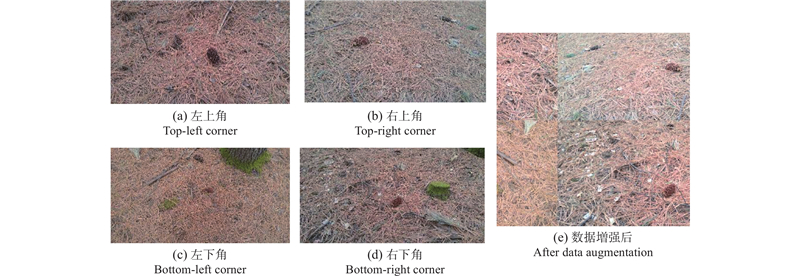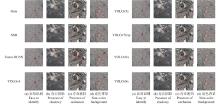

Scientia Silvae Sinicae ›› 2025, Vol. 61 ›› Issue (6): 25-37.doi: 10.11707/j.1001-7488.LYKX20240518
• Research papers • Previous Articles Next Articles
Chenxu Wu( ),Dongyan Zhang*(
),Dongyan Zhang*( ),Lanxiang Zhang,Nuo Chen,Siyu Mao
),Lanxiang Zhang,Nuo Chen,Siyu Mao
Received:2024-09-05
Online:2025-06-10
Published:2025-06-26
Contact:
Dongyan Zhang
E-mail:a2022111824@nefu.edu.cn;nefuzdhzdy@nefu.edu.cn
CLC Number:
Chenxu Wu,Dongyan Zhang,Lanxiang Zhang,Nuo Chen,Siyu Mao. Detection Method of Pinecones in the Forest Based on RT-DETR[J]. Scientia Silvae Sinicae, 2025, 61(6): 25-37.

Fig.7
Data augmentation diagram This diagram illustrates the data augmentation process, with the top left, top right, bottom left, and bottom right representing the four images that have been cropped and enhanced. Each image undergoes processes including cropping, horizontal flipping, and HSV color space augmentation. The resulting stitched image visually demonstrates the diverse samples, aiming to enhance the model's robustness and accuracy."

Table 1
Results of the ablation study"
| RTDETR | REPVIT | HiLo | DRBC3 | Precision(%) | Recall(%) | AP50(%) | GFLOPs | Params(MB) | FPS |
| √ | 88.12 | 87.56 | 89.41 | 56.9 | 40.4 | 74.3 | |||
| √ | √ | 90.95 | 92.11 | 91.85 | 36.3 | 27.6 | 77.5 | ||
| √ | √ | 91.03 | 90.78 | 91.42 | 57.1 | 40.4 | 79.4 | ||
| √ | √ | 90.45 | 91.05 | 91.20 | 48.3 | 36.7 | 77.7 | ||
| √ | √ | √ | 92.12 | 91.80 | 91.95 | 36.5 | 27.6 | 83.8 | |
| √ | √ | √ | 92.50 | 91.85 | 92.31 | 28.5 | 23.9 | 85.7 | |
| √ | √ | √ | √ | 93.30 | 92.65 | 93.37 | 27.8 | 23.8 | 95.5 |
Table 3
Benchmarking results of different detection models"
| 模型Models | Input size | Precision(%) | Recall(%) | AP50(%) | Params/MB | GFLOPs |
| SSD | 300*300 | 90.28 | 60.53 | 65.28 | 26.28 | 62.75 |
| Faster-RCNN | 800*800 | 32.47 | 54.35 | 84.32 | 41.34 | 177.59 |
| YOLOv4 | 416*416 | 93.51 | 62.23 | 77.19 | 63.94 | 59.95 |
| YOLOv5s | 640*640 | 90.48 | 75.18 | 81.31 | 46.63 | 114.56 |
| YOLOv6s | 640*640 | 86.33 | 68.12 | 76.72 | 32.81 | 44.00 |
| YOLOv7tiny | 640*640 | 90.70 | 64.41 | 74.90 | 6.23 | 13.86 |
| YOLOv8n | 640*640 | 84.72 | 69.41 | 81.11 | 6.22 | 8.10 |
| YOLOv8s | 640*640 | 91.47 | 74.65 | 85.92 | 22.51 | 28.40 |
| RT-DETR-R18 | 640*640 | 88.12 | 87.56 | 89.41 | 56.92 | 40.40 |
| Ours | 640*640 | 93.30 | 92.65 | 93.37 | 23.80 | 27.80 |

Fig.8
Comparative diagram of actual detection results This diagram illustrates the actual detection results of the target detection task. Areas identified by the model as pinecones are marked with red boxes, accompanied by their respective confidence scores. The comparison of different detection outcomes allows for a visual understanding of the model's accuracy and reliability in recognizing pinecones."

|
崔 颖, 韩佳成, 高 山, 等. 基于改进Deformable-DETR的水下图像目标检测方法. 应用科技, 2024, 51 (1): 30- 36,91.
doi: 10.11991/yykj.202302003 |
|
|
Cui Y, Han J C, Gao Shan, et al. Underwater object detection method based on improved Deformable-DETR. Applied Science and Technology, 2024, 51 (1): 30- 36,91.
doi: 10.11991/yykj.202302003 |
|
|
程嘉瑜, 陈妙金, 李 彤, 等. 基于改进Faster-RCNN网络的无人机遥感影像桃树检测. 浙江农业学报, 2024, 36 (8): 1909- 1919.
doi: 10.3969/j.issn.1004-1524.20230912 |
|
|
Cheng J Y, Chen M J, Li T, et al. Prunus persica detection in UAV remote sensing images based on improved Faster-RCNN network. Acta Agriculturae Zhejiangensis, 2024, 36 (8): 1909- 1919.
doi: 10.3969/j.issn.1004-1524.20230912 |
|
|
胡佳乐, 周 敏, 申 飞. 面向无人机小目标的RTDETR改进检测算法. 计算机工程与应用, 2024, 60 (20): 198- 206.
doi: 10.3778/j.issn.1002-8331.2404-0114 |
|
|
Hu J L, Zhou M, Shen F. Improved RT-DETR detection algorithm for small UAV targets. Computer Engineering and Applications, 2024, 60 (20): 198- 206.
doi: 10.3778/j.issn.1002-8331.2404-0114 |
|
| 黄启灏, 靳国旺, 熊 新, 等. 通道剪枝与知识蒸馏相结合的轻量化SAR目标检测. 测绘学报, 2024, 53 (4): 712- 723. | |
| Huang Q H, Jin G W, Xiong X, et al. Lightweight SAR object detection combining channel pruning and knowledge distillation. Acta Geodaetica et Cartographica Sinica, 2024, 53 (4): 712- 723. | |
|
李 淼, 王敬贤, 李华龙, 等. 基于 CNN 和迁移学习的农作物病害识别方法研究. 智慧农业, 2019, 1 (3): 46.
doi: 10.12133/j.smartag.2019.1.3.201903-SA005 |
|
|
Li M, Wang J X, Li H L, et al. Research on crop disease identification method based on CNN and transfer learning. Smart Agriculture, 2019, 1 (3): 46.
doi: 10.12133/j.smartag.2019.1.3.201903-SA005 |
|
| 李 翔, 何 淼, 罗海波. 面向遮挡行人检测的自适应收缩非极大值抑制方法. 控制与决策, 2024, 39 (7): 2177- 2185. | |
| Li X, He M, Luo H B. Adaptive contraction non-maximum suppression method for occluded pedestrian detection. Control and Decision, 2024, 39 (7): 2177- 2185. | |
| 刘 龙, 方榉炫, 张梦璇, 等. 基于Transformer特征关联融合小目标检测算法研究. 信号处理, 2024, 15 (3): 1- 26. | |
| Liu L, Fang J X, Zhang M X, et al. Research on small object detection algorithm based on Transformer feature association and fusion. Journal of Signal Processing, 2024, 15 (3): 1- 26. | |
|
罗志聪, 何陈涛, 陈登捷, 等. 基于轻量化YOLO v8s-GD的自然环境下百香果快速检测模型. 农业机械学报, 2024, 55 (8): 291- 300.
doi: 10.6041/j.issn.1000-1298.2024.08.026 |
|
|
Luo Z C, He C T, Chen D J, et al. Fast detection model for Passion fruit in natural environments based on lightweight YOLO v8s-GD. Transactions of the Chinese Society of Agricultural Machinery, 2024, 55 (8): 291- 300.
doi: 10.6041/j.issn.1000-1298.2024.08.026 |
|
| 吕永俊, 王士贤, 彭 芳, 等. 松果有效成分研究——VI. 红松与油松松塔及松子壳的抗癌活性. 大理学院学报, 2008, (2): 1- 2. | |
| Lü Y J, Wang S X, Peng F, et al. Study on the active components of pine cones — VI. anti-cancer activity of pine cones and pine nut shells from Pinus koraiensis and Pinus tabuliformis. Journal of Dali University, 2008, (2): 1- 2. | |
| 齐建东, 郑尚姿, 陈子仪, 等. 基于ConvNeXt的北京地区红外相机野生动物图像识别改进模型构建. 林业科学, 2024, 60 (8): 33- 45. | |
| Qi J D, Zheng S Z, Chen Z Y, et al. Construction of an improved model for wildlife image recognition in Beijing region based on ConvNeXt. Scientia Silvae Sinicae, 2024, 60 (8): 33- 45. | |
| 王文杰, 陈 伟, 路锦通, 等. 基于RT-DETR-Faster的苹果采摘机器人实时目标检测算法. 自动化与仪表, 2024, 39 (7): 57- 62. | |
| Wang W J, Chen W, Lu J T, et al. Real-time object detection algorithm for Malus domestica picking robots based on RT-DETR-Faster. Automation & Instrumentation, 2024, 39 (7): 57- 62. | |
| 王雨博. 一种开环型松塔采摘器设计. 中国科技信息, 2022, (22): 73- 75. | |
| Wang Y B. Design of an open-loop pine cone picker. China Science and Technology Information, 2022, (22): 73- 75. | |
| 王智航, 张永红, 于婉婷, 等. 红松松塔、松子壳研究进展及在畜牧业中应用可行性分析. 国外畜牧学(猪与禽), 2009, 29 (4): 88- 90. | |
| Wang Z H, Zhang Y H, Yu W T, et al. Research progress on pine cones and pine nut shells of Pinus koraiensis and feasibility analysis of their application in animal husbandry. Animal Science Abroad(Pigs and Poultry), 2009, 29 (4): 88- 90. | |
| 邢远秀, 刘颛玮, 邢玉峰, 等. 2024. BDD-DETR: 高效感知小目标的锂电池表面缺陷检测. 储能科学与技术, 1−10. | |
| Xing Y X, Liu Z W, Xing Y F, et al. 2024. BDD-DETR: efficient detection of lithium battery surface defects for small object perception. Energy Storage Science and Technology, 1−10. [in Chinese] | |
|
徐丹青, 吴一全. 光学遥感图像目标检测的深度学习算法研究进展. 遥感学报, 2024, 46 (19): 1- 30.
doi: 10.11834/jrs.20243166 |
|
|
Xu D Q, Wu Y Q. Research progress on deep learning algorithms for object detection in optical remote sensing images. National Remote Sensing Bulletin, 2024, 46 (19): 1- 30.
doi: 10.11834/jrs.20243166 |
|
|
杨文翰, 刘天宇, 周俊池, 等. 基于改进YOLOv5s的CNN-Swin Transformer森林野生动物图像目标检测算法. 林业科学, 2024, 60 (3): 121- 130.
doi: 10.11707/j.1001-7488.LYKX20220597 |
|
|
Yang W H, Liu T Y, Zhou J C, et al. An improved YOLOv5s-Based CNN-Swin transformer algorithm for object detection of forest wildlife images. Scientia Silvae Sinicae, 2024, 60 (3): 121- 130.
doi: 10.11707/j.1001-7488.LYKX20220597 |
|
| 张国立, 常 帅, 宋延嵩, 等. 基于可变形卷积和多尺度残差注意力的多光谱行人检测. 激光与光电子学进展, 2024, 61 (10): 359- 366. | |
| Zhang G L, Chang S, Song Y S, et al. Multi-spectral pedestrian detection based on deformable convolution and multi-scale residual attention. Laser & Optoelectronics Progress, 2024, 61 (10): 359- 366. | |
| 张惠莉, 代晨龙, 任景龙, 等. 2024. 基于GhostNetV2改进YOLO v8模型的葡萄病害识别方法研究. 农业机械学报, 1−11. | |
| Zhang H L, Dai C L, Ren J L, et al. 2024. Research on Vitis vinifera disease identification method based on improved YOLO v8 model with GhostNetV2. Transactions of the Chinese Society for Agricultural Machinery, 1−11. [in Chinese] | |
| Carion N, Massa F, Synnaeve G, et al. 2020. End-to-end object detection with transformers. European conference on computer vision. Cham: Springer, 213−229. | |
| Dosovitskiy A. 2020. An image is worth 16x16 words: transformers for image recognition at scale. arXiv: 2010.11929 | |
| Girshick R, Donahue J, Darrell T, et al. 2014. Rich feature hierarchies for accurate object detection and semantic segmentation. Proceedings of the IEEE conference on computer vision and pattern recognition(CVPR), 580−587. | |
| Girshick R. 2015. Fast r-cnn. Proceedings of the IEEE international conference on computer vision(ICCV), 1440−1448. | |
| He K, Zhang X, Ren S, et al. 2016. Deep residual learning for image recognition. Proceedings of the IEEE conference on computer vision and pattern recognition(CVPR), 770−778. | |
| Koonce B. 2021. Convolutional neural networks with Swift for TensorFlow: Image recognition and dataset categorization. Berkeley: Apress, 125–144. | |
| Liu W, Anguelov D, Erhan D, et al. 2016. Ssd: Single shot multibox detector//European conference on computer vision. Cham: Springer, 21−37. | |
| Ren S, He K, Girshick R, et al. Faster R-CNN: towards real-time object detection with region proposal networks. IEEE Transactions on Pattern Analysis and Machine Intelligence, 2016, 39 (6): 1137- 1149. | |
| Redmon J, Divvala S, Girshick R, et al. 2016. You only look once: unified, real-time object detection. Proceedings of the IEEE Conference on Computer Vision and Pattern Recognition(CVPR), 779−788. | |
| Selvaraju R R, Cogswell M, Das A, et al. 2017. Grad-cam: visual explanations from deep networks via gradient-based localization. Proceedings of the IEEE International Conference on Computer Vision(ICCV), 618−626. | |
| Tan M, Pang R, Le Q V. 2020. Efficientdet: scalable and efficient object detection. Proceedings of the IEEE/CVF Conference on Computer Vision and Pattern Recognition(CVPR), 10781−10790. | |
| Vaswani A. 2017. Attention is all you need. Advances in Neural Information Processing Systems. arXiv: 1706.03762 | |
| Wang P, Chen P, Yuan Y, et al. 2018. Understanding convolution for semantic segmentation. IEEE Winter Conference on Applications of Computer Vision(WACV), 1451−1460. | |
| Zhao Y, Lü W, Xu S, et al. 2024. Detrs beat YOLOs on real-time object detection. Conference on Computer Vision and Pattern Recognition(CVPR), 16965−16974. |
| No related articles found! |
| Viewed | ||||||
|
Full text |
|
|||||
|
Abstract |
|
|||||